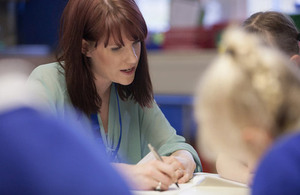Mental health behaviour guidance to be issued to schools
New guidance helps teachers to identify bad behaviour from poor mental health.

Teacher working with students
New guidance published today by the government will help teachers better identify underlying mental health problems in young people – meaning fewer pupils will wrongly be labelled trouble-makers.
Education Minister Elizabeth Truss said it would help ensure pupils with unmet mental health needs will get the help they need at an earlier stage. A 2012 Centre for Mental Health report estimates around 15% of pupils aged 5 to 16 have mental health problems that put them at increased risk of developing more serious issues in the future.
At the same time, it will enable teachers to be more confident in spotting those children who are simply behaving badly, and do not have a mental health issue.
The guidance, created by the Department for Education in consultation with headteachers, mental health professors and the Department of Health, is designed to ensure teachers are confident in finding help for at-risk pupils.
The guidance outlines to schools that they could use pupil questionnaires, teacher training toolkits and mental health factsheets to help identify potential issues. This means problems can be tackled before they become more serious, as well as helping schools know when to refer pupils to mental health experts, such as the Child and Adolescent Mental Health Services (CAMHS).
The guidance also outlines what schools can do to provide a stable environment for their pupils. This includes:
- clear bullying and behaviour policies
- working with parents and carers as well as pupils
- introducing peer mentoring systems
- discussing mental health issues as part of the wider curriculum
Education Minister Elizabeth Truss said:
At the moment too many young people are unfairly labelled as trouble-makers when in fact they have unmet mental health problems.
Good mental health among pupils is fundamental to their wellbeing and success. We know schools want clear guidelines on how best to separate poor behaviour from underlying mental health issues.
Teachers are not therapists but they play a vital role in the lives of their pupils. A healthier, happier classroom allows teachers to get on with what they do so well – teaching and inspiring the next generation.
She added:
Teachers know their pupils and have real influence – but at the same time they understandably sometimes feel uncertain about what exactly they should do, or when to act.
Teachers who know how and when to help can make all the difference for children with mental health problems.
Examples of schools that currently handle their pupils’ mental health well include:
-
St Marylebone C of E School, in Westminster, London, where teachers use its curriculum to promote well-being. Pupils learn that mental health is as important as physical health, and that relaxation and contemplation can foster positive mental health
-
Hardenhuish School, an academy in Chippenham, Wiltshire, uses pastoral managers to support pupils before, during and after their involvement with CAMHS. They also have peer mentoring system between their 17-year-old and 15-year-old pupils
Teacher Fran Congdon, senior leader of personal, social, health and economic education (PSHE), at St Marylebone C of E School, in Westminster, London, said:
I welcome these guidelines that enable schools to review their provision and adopt a strategic and informed approach to emotional and mental health in school.
School is a formative time for young people, during which their character and values are developing. Therefore it is essential to equip them with strategies to manage their own emotional lives, social pressures and personal goals and obstacles.
Mick Cooper, Professor of Counselling Psychology at the University of Roehampton, said:
Guidelines for addressing mental health issues in schools are an important new development. Schools should be positive and affirming of young people and help them explore and address emotional, as well as educational, problems.
Research shows that young people with mental health issues can find it difficult to concentrate and learn at school. Addressing these problems early on may help young people to make the most of their education and wider life.
Peter Fonagy, Professor of Psychoanalysis and Head of Clinical, Educational and Health Psychology at University College London, said:
These new guidelines will be an invaluable tool for all of us involved in this most important of all social responsibilities: ensuring that children and families obtain the high quality of support they deserve.
Schools have a critical part to play in building resilience in our children. Schools are well placed to help troubled youngsters by understanding their individual needs. Schools can then support them in a normal, non-stigmatizing environment.
Philip Rush, Principal of St Peter’s High School in Stroud, Gloucestershire, said:
All schools need to treat mental health issues with care and professional expertise.
I welcome this new guidance as many pupils may be suffering, sometimes as the result of chronic conditions, sometimes as the result of trauma or tragedy, or sometimes as part of wider health issues.
Notes to editors
- View the ‘Mental health and behaviour in schools’ guidance.
- According to the latest Office for National Statistics (ONS) data, 9.8% of children and young people aged 5 to 16 have a clinically diagnosed mental disorder. A 2012 Centre for Mental Health report estimates a further 15% have less severe problems that put them at increased risk of developing mental health problems in the future.
- 2013 NICE guidance identifies pupils that have a conduct disorder as often having underlying mental health problems.
DfE media enquiries
Central newsdesk - for journalists 020 7783 8300